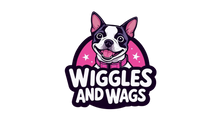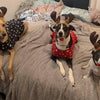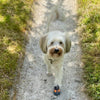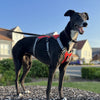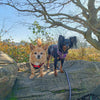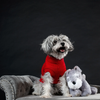The Best Ways To Bond With My Dog - Our top 10
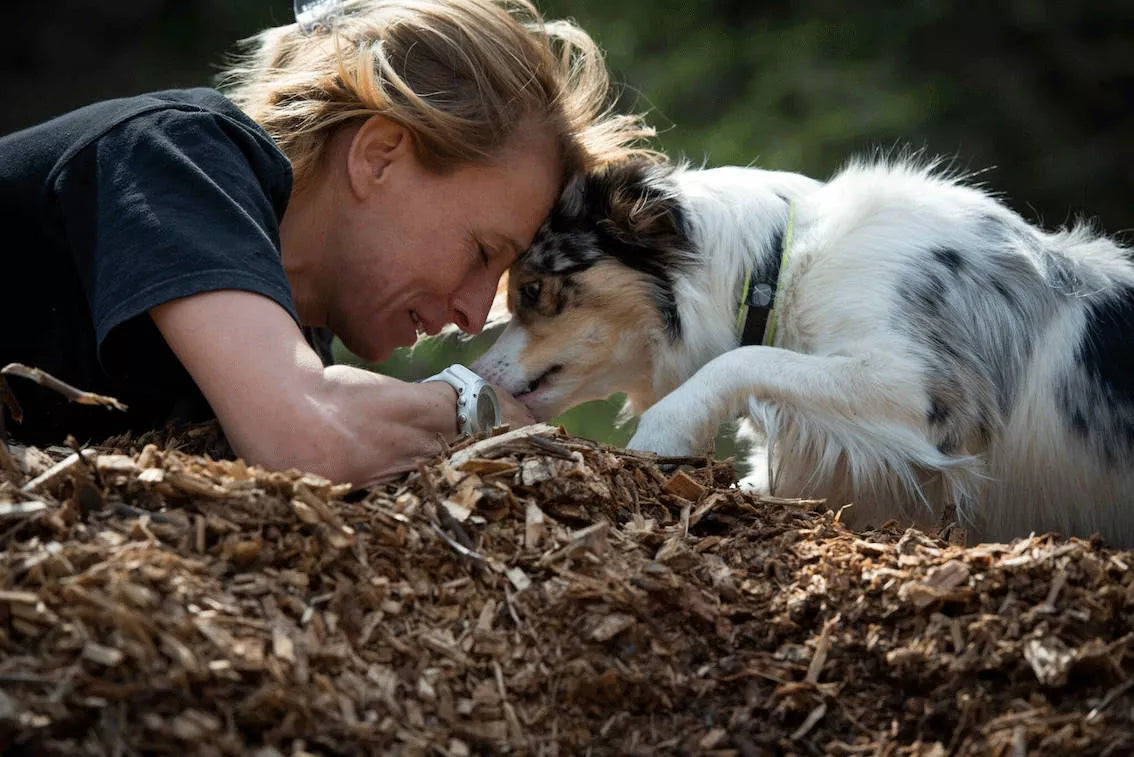
The snugglezzz team offer their top 10 ways to bond with your dog. Although this is not and exhaustive or definitive guide, we do feel that we have gone some way in coming up with a great top 10.
10 - Happy families  Anyone who’s ever welcomed a dog into their life knows they richly deserve their nickname of “man’s best friend”. Like every friendship though, it needs work to develop into a lasting bond.
Anyone who’s ever welcomed a dog into their life knows they richly deserve their nickname of “man’s best friend”. Like every friendship though, it needs work to develop into a lasting bond.
Ideally the work should begin as soon as you decide to get a dog. How will they fit in to your lifestyle? If you live in the heart of the city, for instance, you may want to think twice about getting a country hunting dog. And if you already have pets, how will your animals get along together? Although the age of your new dog is a factor, with puppies especially trusting and eager to please, that doesn’t mean you can’t bond with an older dog.
If adopting an older animal, if possible, find out about your dog’s history. And remember, even though your heart may be set on a particular breed, you just might be led by an engaging dog personality and big brown eyes from another breed.
When your pet arrives, take things slowly. Don’t force them out of the pet carrier before they’re ready – entice them out gently with food and gentle, calm tones.
Once they’re out, let them explore their new environment in their own time and don’t overwhelm them. If you have a large family, let your new dog meet them one at a time. And from the start, establish regular routines and firm but fair rules – this will help you both know what to expect as your dog becomes truly part of the family.
9 - Rules and routines Dogs, like most children (and many adults!) benefit from routines, rules and regulations, so as soon as your new family member arrives, work on building that structure into both your lives. For every dog, whether they’re a tiny puppy or an older animal, joining your family involves changes to their routines. Be patient at first – it will take some time before your canine companion feels secure in their new world. Routines for waking up, toileting, feeding, walks and playtime will benefit everyone.
Dogs, like most children (and many adults!) benefit from routines, rules and regulations, so as soon as your new family member arrives, work on building that structure into both your lives. For every dog, whether they’re a tiny puppy or an older animal, joining your family involves changes to their routines. Be patient at first – it will take some time before your canine companion feels secure in their new world. Routines for waking up, toileting, feeding, walks and playtime will benefit everyone.
Regular feeding routines will help your dog maintain regular toileting habits too. Especially in the early days, you may find a few accidents, escape attempts and tummy upsets – but perseverance will be rewarded.
Consistency is vital throughout. Set rules and keep to them – if your dog is not allowed on the sofa or the bed, make sure all family members take the same approach. Otherwise your dog will just get confused. And if you’re taking your dog on holiday or there are other changes to his or her routine, try to keep the core of her day secure – wake up, feed, toilet and walk at the same times if at all possible.
As far as your dog is concerned, your family is their pack, and you’re their pack leader. They will look to you to see how to behave and what’s acceptable. So keep it calm, keep it consistent, and keep it strict but fair – just one more way of building a bond with your dog that will last a lifetime.
8 - Walkies! If there is one word that is guaranteed to get a response out of every dog, it has to be “walk” (and all its variations). All dogs need exercise, and walking is one of the very best ways for you to bond.
If there is one word that is guaranteed to get a response out of every dog, it has to be “walk” (and all its variations). All dogs need exercise, and walking is one of the very best ways for you to bond.
Many experts recommend at least 30 minutes exercise daily: some dogs need more. Although all that energy might be a little daunting at first, turn it into an asset. Build games with retrieval toys into your walks; your dog needn’t know you’re sneakily including obedience training with the fun.
Once you’re happy that your dog will come back when off the leash, you can be more adventurous. Head for a dog friendly beach or into a country area where you can let your pet off the lead to run about freely.
If you’re in a situation where dogs need to be kept on the lead keep him on a loose leash, and let him have plenty of time to explore. For city dogs, head for the nearest park or embankment – as seasons change, there’ll be masses of interesting new smells and features to explore.
So, what are your secret ingredients for a successful walk? Pack a toy or two; plastic bags; a couple of treats; and a dog coat for chilly or damp weather. Keep old towels in the car or by the door for when you arrive back. And as soon as you’ve got your routine sorted, you’ll probably find your dog reminds you when it’s time for walkies.
7 - The way to a dog’s heart… The way to a dog’s heart is definitely through good food – which can offer you great opportunities to bond with your pet. Glossy coat, healthy pink tongue, bright eyes, clean teeth, limber but not too thin, and a healthy scent – it’s easy to spot a canine enjoying good nutrition. Like people, all dogs have their favourite foods.
The way to a dog’s heart is definitely through good food – which can offer you great opportunities to bond with your pet. Glossy coat, healthy pink tongue, bright eyes, clean teeth, limber but not too thin, and a healthy scent – it’s easy to spot a canine enjoying good nutrition. Like people, all dogs have their favourite foods.
Dogs need daily protein, fat, vitamins and water to keep them in tip-top health. Most experts recommend a mix of wet and dry food – wet food usually has more protein, but dry food has been specially formulated. Check the packaging for portion recommendations – as with humans, obesity has become something of a problem recently for many dogs, so be careful not to overfeed.
Don’t make a habit of feeding your dog scraps from your own plate – though the occasional treat won’t hurt. Although some dogs have a particular partiality to cheese, dairy products and ice cream, some human foods can be harmful if not downright dangerous to dogs. Avoid onions, garlic, raisins or grapes, avocado and dried, uncooked beans; and don’t ever give a dog chocolate designed for human consumption – it’s potentially poisonous.
Make sure bowls are clean and water fresh and try dipping your finger into the bowl as the dog is feeding. This tests whether your dog is very protective and potentially guarding when it comes to eating and it is a good way to cement trust from both sides. Also, try not to feed your dog within an hour each side of exercise or just before you’re about to go travelling. As with all your dog’s daily rituals, make food available at the same time and place. The more your dog knows what to expect from you as pack leader, the stronger your bond will become.
6 - Health and beauty
You owe it to your pet to establish a strong health and grooming routine. Nutrition and exercise are part of it, as are regular checkups and looking after your dog’s ongoing health needs. As you and your dog get to know one another better, you’ll soon know if they’re feeling unwell.
Find a vet you trust – visiting the vet can be traumatic, but essential to keep your pet in tip-top health. Your vet will make sure your dog’s vaccinations are up-to-date, carry out any health checks and teeth cleaning needed, and advise you on diet, exercise, and health problems specific to the breed or age of your dog.
Don’t ignore the beauty aspects either. Although grooming can be a great way to bond, some canines enjoy being brushed daily, others not so much. Some will just adore a trip to a professional groomer, others just want the doggy equivalent of a short back and sides – again, listen to your dog.
And then there’s bathing. All dogs need to have regular baths or showers, around once a month, but just how regular depends on the individual dog. And though most dogs seem to love rolling in pond water and the sea, some are not quite so keen on the whole bathing to get clean thing. If it’s warm enough to bath your dog outside, think about turning it into a game with the hose or water spray. It doesn’t have to be a battle – turn it into a bonding ritual instead.
5 - The power of patience
Like all good relationships, creating a lasting bond with your dog takes time, and the importance of patience can’t be overstated. Be careful not to overwhelm your new buddy with too many sensations, especially in the early days. Don’t inflict the whole family on them the second they arrive in their new home, for instance. Let him meet you all one at a time. And allow your new dog plenty of time to feel safe, explore her surroundings and get used to new scents and sensations.
Be patient as your dog learns his or her food, walking, toileting and play routines. Keep your tone calm at all times. Yelling is counterproductive. Instead use firm commands in high or low voice tones - if you shout loudly your dog may just see it as a bark back! Your pet needs to know you’re in control – the dependable pack leader at all times.
Be patient as you get to know one another. If you made a new human friend you wouldn’t expect to understand them immediately – you’d get to know one another gradually, and it’s just the same with your dog. If you have a dog who has had behavioural difficulties in the past, it doesn’t always mean that pattern will continue, if you are patient and loving and work on developing your bond.
Show patience as you’re learning what type of exercise and play routine your dog enjoys too – and be aware that, as your dog goes through his or her lifecycle, its needs change. Get the fundamentals right early on, and you’ll have a friend who will give you unconditional love and support for life.
4 - Socialisation Early socialising is essential for dogs and owners to establish and build a lasting bond – and there are many fun ways to achieve effective socialisation. All dogs need to learn how to behave around other dogs and humans in a range of situations and environments.
Early socialising is essential for dogs and owners to establish and build a lasting bond – and there are many fun ways to achieve effective socialisation. All dogs need to learn how to behave around other dogs and humans in a range of situations and environments.
One option is to take your pup along to formal socialisation classes, where he can be introduced to other dogs in a semi-formal, structured way. Look up your local branch of the Kennel Club - many run local courses and most welcome new members. As well as being beneficial for your dog, it offers you the chance to meet and interact with other owners.
Another possibility is to take your dog along to one of the many dog shows held around the country – not the pedigree “Crufts” type, but rather the fun family events, for ordinary pets and working dogs. You and your pet will usually get the chance to try out new toys, encounter other canines, and get to see new products to make everyone’s life easier and more comfortable. There will be the chance to socialise with adult dogs, puppies, and a wide range of people.
Make sure your pup has had his or her vaccinations before you start on your socialisation routines, and do bear in mind that dogs of different breeds and temperaments may have differing timescales for how soon they feel comfortable in social situations. It’s all about making your pet feel safe – and will pay dividends for both of you.
3 - Play A healthy, happy dog has masses of energy – and all that energy must go somewhere. If you don’t channel it into play and exercise, you may find your dog becoming destructive.
A healthy, happy dog has masses of energy – and all that energy must go somewhere. If you don’t channel it into play and exercise, you may find your dog becoming destructive.
Most dogs love to play – whether it’s his favourite game of “fetch” or a good romp along the water’s edge when walking in the park, country or at the beach. (This last activity is preferably followed by a good roll in the muddiest, stickiest bracken area and a vigorous shaking of water over anyone fortunate enough to be nearby.)
Aim for short and energetic bursts of play. Use lots of praise and a happy voice, and if he’s not in the mood to play, don’t force him. (Though if a normally very playful dog suddenly doesn’t want to play, you might want to check out if he’s feeling okay.) Always provide adequate water breaks as some dogs (especially short nosed dogs) can overheat quickly, especially in hot weather.
Incorporate games into your dog’s daily routine – be sneaky and include a few obedience commands too. If it is raining (not unusual in the northern hemisphere!), then either pull on your wellies and waterproofs, or if it’s really bucketing down, think about indoor games.
Unless you have a huge (and empty!) house, games like chase and fetch are impractical indoors, but you can still play games like tug-of-war or hide and seek. If tug is your game of choice, make sure that your dog doesn't win the battle too often and try to get the dog to stop and let go of the rope or toy. This teaches them to be a little more controlled and also means that you (as pack leader) are still top dog!
Dogs also need suitable toys. Swap the toys every few days – try playthings with squeaks; toys on ropes; rubber rings and rubber balls. You can also buy specially designed interactive games for your dog – entertaining for all concerned.
2 - Communicate
The basis of all effective relationships is communication. Although your dog may not be able to talk (though many owners would disagree!), he has dozens of other ways to tell you how he’s feeling, from body language to barks, growls and yelps.
Start with eye contact – but don’t stare, most dogs will look away as this is threatening. Just as with humans, body posture is important – a confident dog stands tall, tail up and wagging slowly, and if the pupils are small, this shows he or she is relaxed.
Eyes, tail, bottom and tummy – all give unmistakable signals to the observant owner. If your pet wants to play they may stick their rear quarters in the air and drop their head and chest to the ground. Others use nudges to convey the same message or resort to the “paw on the knee” routine.
Rolling over and showing the tummy can indicate a desire for a tummy rub, or respect for authority (yours, hopefully!). The tail also reveals your dog’s mood – if up in the air, your pet is feeling confident, assertive or excited; if the tail is lower than the body or between your dog’s legs, then your pet is feeling uncertain, afraid or in need of reassurance.
Dogs also show their emotions with their faces – ears can give away how they’re feeling, and you’ll soon know when your dog is smiling. It’s a lifetime’s work to get to know how your dog communicates - but one full of rewards.
1 - Love them It may sound sentimental, but the very best way to bond with your dog is to love them and welcome them into your life as another member of the family.
It may sound sentimental, but the very best way to bond with your dog is to love them and welcome them into your life as another member of the family.
Though they’re man’s best friend and will protect you to the death, you also have a responsibility to your dog. From day one, your dog needs to know you are there to look after their basic needs – food and water, shelter, health and exercise.
Help them establish a daily routine – necessary for both of you, and be firm, fair, calm and consistent with your rules. Make sure your pet has all the appropriate nutrition they need, fresh water, and a warm, safe place of their own to sleep, with toys and toilet facilities.
Look after their health and beauty routine too. Take them to the vet for annual check-ups, boosters and whenever their health needs it. Keep your dog’s coat clean and glossy with regular baths and brushing, and depending on the breed, trips to the grooming parlour.
Take dogs for exciting walks in their favourite places – and experiment with coast, country, parks and other environments to find new places with interesting smells and sensations. Find out about their favourite ways to play and the toys they like. Take them to socialisation classes and fun dog shows. Listen to their body language and help them understand what yours means – it’s all about building the relationship, and creating a bond for life.
Dogs are special and as the last 15,000 years have proved, they provide a loving and supportive role to domestic life for millions of owners around the world. Treat them with the same kindness and love they give you and remember you are the leader and the one who must control things! We hope you have enjoyed our top 10 ways to bond with your dog and we always welcome comments and additions.
